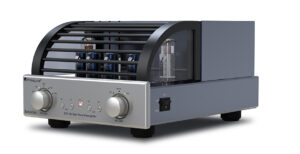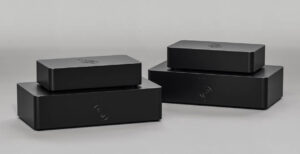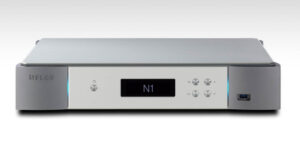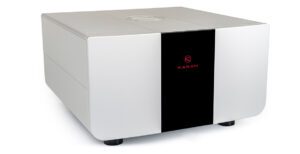
If you judge your books by their covers you’d not be inclined to give this German turntable a second glance. The STST Motus II looks like yet another solid plinth design with a medium mass platter and some nice woodwork. The deck is a bit chunkier than most, but is otherwise devoid of any hint at what lies beneath. I could be wrong, but there can’t be many other turntables around that combine the technologies hidden within this one, for the Motus II has both direct drive and a suspended subchassis. I knew you’d be surprised!
The plinth that you see is effectively only a cover. It hides the complex internal workings and keeps the dust out; neither the arm nor the platter are fixed to it, and set up involves removing it altogether. The plinth/cover is also the only part that’s made of wood; you can have a variety of attractive veneers and a contrasting or matching top plate. It’s attractively discreet by the oil rig standards of some turntables. The workings underneath are pretty unusual to say the least, as the illustration hopefully reveals the subchassis is supported at three points, but what’s harder to see is that each of these points contains an adjustable leaf spring that provides a degree of damped isolation. I recall that Pink Triangle used leaf springs back in the 1980s, but not like these. This is not box-bound thinking.

The brass weights on the subchassis act to counterbalance the tonearm which is supported on the large tubular section at the opposite end, the weights can be changed and moved to suit different tonearms. Importer Pure Audio is run by Guy Sargeant, formerly of Voyd turntables (a three motor suspended design), and he has found that the Motus II works well with SME, Fidelity Research, and Alphason arms, but unsurprisingly recommends STST’s own arm – specifically the Vertex with which this turntable was supplied.
The direct drive motor on the Motus II was developed by company founder Stefan Strohmetz and differs from the type found on DJ oriented turntables by virtue of having very low torque. We in fidelity-appreciating circles do not need our turntables to get up to speed in a tenth of a revolution, so there’s no need to have loads of power available that will inevitably dissipate energy into the platter and undermine the cartridge’s ability to accurately trace the groove. The appeal of direct drive is that you eliminate the potential speed variations that a drive belt can introduce, but the drawback is that you have a motor attached firmly to the platter and that any extraneous vibrations it produces will get to the platter and thence the vinyl. By using a low torque motor and a six kilo platter to provide inertia, STST is doing its best to minimise unwanted energy transfer and damping it with a Delrin platter, which is a relatively soft plastic compared to acrylic.
The stiffer parts of the Motus II – including the subchassis – are made of composite materials, the overall aim being to absorb and diffuse vibration. Build quality is high throughout. I particularly like the way that the armboard is a large cap that fits over the cylindrical base in the subchassis. The Vertex arm can be had in nine, ten and 12-inch variants, but you’ll need the larger version of the Motus II for the longest arm. The arm combines a carbon fibre tube with machined Delrin bearing housings, headshell, etc. The only metal parts apart from nuts and bolts are the counterweight, its stub, and the main shaft. Adjusting downforce is a slightly tricky affair and fully dynamic in operation, there is no adjustable spring to aid this process. The headshell combines a hole and a curved slot, so overhang is fixed and only the angle can be adjusted, VTA can be tweaked in the usual way as can azimuth. The Vertex arm supplied had a short and vintage Audio Note (Japan) silver cable, which may (or may not) be available from Pure Sound, although similar alternatives exist.
15 DC Volts of regulated power are provided by a separate supply in a good quality housing that can remain out of site because on/off and speed switching are achieved with a switch hidden underneath the plinth. The only practical issue I encountered was that the line and weight anti-skate mechanism clashes with the lift/lower lever and causes the filament to come off its pulley, but it may be possible to adjust set-up to avoid this. It’s worth mentioning that despite appearances the Motus II is supplied with a dust lid, a very useful piece of kit in all but the most airtight domiciles.

The turntable was supplied with a Hana SL moving coil cartridge and I hooked it up to my Trilogy 907 phono stage with impedence set to 400 Ohms and medium gain. The result was beguiling tone from the off with good separation of instruments and voices and very juicy bass guitar. It’s not the most pacey sound, but has a degree of finesse that’s very appealing; image depth is also very good indeed. Compelling without being forward and assured without being ponderous it does a great job with Tom Waits’ voice on the track ‘Underground’ [Swordfishtrombones, Island]. The voice seems a bit more forward in the mix than I’m used to, but this enhances both intelligibility and intimacy. The sense of timing seems natural and easy, your foot doesn’t tap involuntarily, but the music flows in a convincing fashion. And then someone plays an electric guitar and the shine and attack of the notes pull you into the experience in full effect.
The Motus II has a similarly calm presentation to an SME Model 20 but with a rounder and richer tonal character; that is, it extracts more of the tonal depth from records. It likes a well-isolated stand however; a standard Target table doesn’t allow the STST to deliver the goods nearly as well as a Townshend Seismic Stand, but suspension or no ’twas ever thus. In an effort to find what the Motus II can do with a better cartridge I went through the fiddle of installing a Transfiguration Proteus moving coil and connecting this to Tom Evans’ Groove+ SRX MkII phono stage. This killer combo brought a lot more presence, shape, and texture to the musical picture, with voices sounding considerably better thanks to enhanced detail resolution across the board but most obviously in the treble. With Esperanza Spalding’s song ‘Judas’ [Emily’s D+EvolutionConcord] there was less emphasis on the groove than usual, but high levels of detail apparent in long reverb tails and rich articulation of the voice. The bass is sinuous and tuneful with excellent flow as one expects of this remarkable singer/fretless bass player. With this and subsequent slabs of vinyl, the degree of separation was in the premier league. The cartridge clearly worked well with the arm and proceeded to extract vibrant brass, rich voices, ‘phat’ bass lines, and plenty of variation in tonal character between the various sound sources in each mix. ZZ Top’s ‘I’m Bad, I’m Nationwide’ [Deguello, Warner Bros] isn’t quite as locked down in the tempo department as possible but more than makes up for it with lots of reverb and sizzle from drum kit and guitar. Cymbals are also particularly well served, but not because of any brightness in the presentation. The Motus II has an ease and effortlessness that’s rare when combined with high transparency; it’s precise without being emphatic and that makes for very enjoyable listening regardless of musical style.
With Bizet’s ‘Carmen’ [España, NSO, Chasing the Dragon] the Motus II produced massive depth of soundstage alongside nice transients and complete control, the mezzo soprano voice remaining assured and extended regardless of the tracking challenge. It’s one of those source components that gives the impression of having all the time in the world to resolve the recording, it’s not slow but it won’t be rushed. There are better timed turntables on the market to be sure and if you are looking for the propulsive drive of jazz and rock they might be preferable, but if you enjoy instrumental and vocal tone in the context of a stable but lively presentation, there is an awful lot to like about the STST Motus II. What the turntable does so well is make music that is so rewarding all other considerations are set aside, which is not something you can say of all turntables by any means. If you want a turntable that does both fine detail resolution and emotional communication this is definitely one for the shortlist.

TECHNICAL SPECIFICATIONS
- Type: Full-size, direct-drive turntable with suspended subchassis
- Rotational Speeds: 33 1/3 RPM, 45 RPM
- Supported Tonearm Length(s): 9-inch to 12-inch arms supported
- Drive Mechanism: Low torque direct drive
- Speed Control: Not specified
- Platter Type: Delrin engineering plastic
- Platter Weight: 6kg
- Bearing Type: Inverted
- Plinth Configuration: Leaf spring suspended subchassis
- Dimensions (H×W×D):
220 ×480 ×400mm - Weight: 20kg
- Price: £6,399 (turntable), £3,399 (arm)
Manufacturer: STST HiFi
URL: stst-hifi.de
UK Distributor: Pure Sound
Tel: 01822 612449
URL: puresound.info
Tags: FEATURED
By Jason Kennedy
More articles from this authorRead Next From Review
See all
PrimaLuna EVO 100 phono preamplifier
- Apr 22, 2024

Reiki Audio SuperSwitch Master Pro + Servant Pro
- Mar 27, 2024

Melco Audio N1-S38 music server
- Mar 27, 2024











